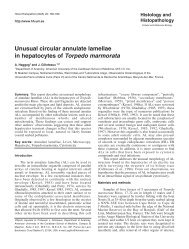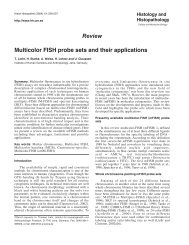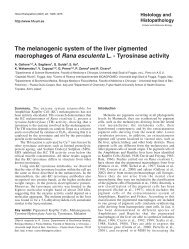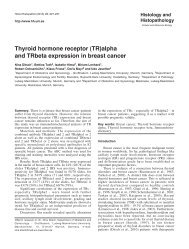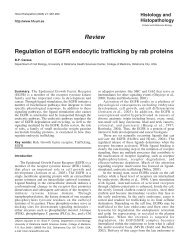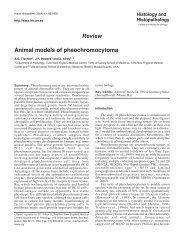Expression profile of tight junction protein claudin 3 and claudin 4 in ...
Expression profile of tight junction protein claudin 3 and claudin 4 in ...
Expression profile of tight junction protein claudin 3 and claudin 4 in ...
Create successful ePaper yourself
Turn your PDF publications into a flip-book with our unique Google optimized e-Paper software.
Histol Histopathol (2007) 22: 1185-1195<br />
http://www.hh.um.es<br />
Histology <strong>and</strong><br />
Histopathology<br />
Cellular <strong>and</strong> Molecular Biology<br />
<strong>Expression</strong> <strong>pr<strong>of</strong>ile</strong> <strong>of</strong> <strong>tight</strong><br />
<strong>junction</strong> <strong>prote<strong>in</strong></strong> <strong>claud<strong>in</strong></strong> 3 <strong>and</strong> <strong>claud<strong>in</strong></strong> 4 <strong>in</strong><br />
ovarian serous adenocarc<strong>in</strong>oma with prognostic correlation<br />
Y.-L. Choi 1 , J. Kim 1 , M.J. Kwon 2 , J.-S. Choi 3 , T.-J. Kim 4 ,<br />
D.-S. Bae 4 , S.S. Koh 5 , Y.-H. In 6 , Y.W. Park 7 , S.H. Kim 8 , G. Ahn 1 <strong>and</strong> Y.K. Sh<strong>in</strong> 2<br />
1 Department <strong>of</strong> Pathology, Samsung Medical Center, Sungkyunkwan University School <strong>of</strong> Medic<strong>in</strong>e, Seoul, Korea, 2 Laboratory <strong>of</strong> Molecular Pathology,<br />
Department <strong>of</strong> Pharmacy, Seoul National University College <strong>of</strong> Pharmacy, Seoul, Korea, 3 Department <strong>of</strong> Pathology, Cheil General Hospital,<br />
Sungkyunkwan University School <strong>of</strong> Medic<strong>in</strong>e, Seoul, Korea <strong>and</strong> 4 Department <strong>of</strong> Obstetrics <strong>and</strong> Gynecology, Samsung Medical Center, Sungkyunkwan<br />
University School <strong>of</strong> Medic<strong>in</strong>e, Seoul, Korea, 5 LG Life Sciences, Ltd., R&D Research Park, Daejeon, Korea, 6 BIT center, CT&D Ltd., Seoul, Korea,<br />
7 Korea Research Institute <strong>of</strong> Bioscience <strong>and</strong> Biotechnology, Daejeon, Korea <strong>and</strong> 8 Department <strong>of</strong> Pathology, Chungbuk National University College <strong>of</strong><br />
Medic<strong>in</strong>e, Cheongju, Chungbuk, Korea<br />
Summary. Tight <strong>junction</strong> <strong>prote<strong>in</strong></strong>s <strong>claud<strong>in</strong></strong> 3 (CLDN3)<br />
<strong>and</strong> <strong>claud<strong>in</strong></strong> 4 (CLDN4) are frequently altered <strong>in</strong> several<br />
human cancers, <strong>in</strong>clud<strong>in</strong>g ovarian carc<strong>in</strong>omas. Here, we<br />
exam<strong>in</strong>ed the gene expression <strong>of</strong> CLDN3 <strong>and</strong> CLDN4 <strong>in</strong><br />
various tumors, <strong>in</strong>clud<strong>in</strong>g 19 normal ovaries <strong>and</strong> 47<br />
ovarian carc<strong>in</strong>omas by analyz<strong>in</strong>g Affymetrix HG-U133<br />
array data. Furthermore, a total <strong>of</strong> 114 ovarian serous<br />
tumors, <strong>in</strong>clud<strong>in</strong>g 10 adenomas, 20 borderl<strong>in</strong>e tumors<br />
<strong>and</strong> 84 carc<strong>in</strong>omas, were analyzed immunohistochemically<br />
to confirm the expression <strong>of</strong> two <strong>prote<strong>in</strong></strong>s <strong>and</strong><br />
we assessed the association <strong>of</strong> their expression with the<br />
cl<strong>in</strong>icopathological characteristics <strong>and</strong> survival <strong>of</strong> the<br />
patients. The microarray experiment revealed CLDN3<br />
<strong>and</strong> CLDN4 transcripts were significantly up-regulated<br />
by 5-fold or more <strong>in</strong> most subtypes <strong>of</strong> ovarian epithelial<br />
carc<strong>in</strong>omas while the immunohistochemical analyses<br />
<strong>in</strong>dicated that each <strong>prote<strong>in</strong></strong> was expressed <strong>in</strong> 68 (81.0%)<br />
<strong>and</strong> 72 (85.7%) <strong>of</strong> 84 serous adenocarc<strong>in</strong>omas,<br />
respectively. Borderl<strong>in</strong>e serous tumors <strong>and</strong> adenomas<br />
showed significantly lower expression <strong>of</strong> these <strong>prote<strong>in</strong></strong>s<br />
than the adenocarc<strong>in</strong>omas. Kaplan-Meier survival<br />
analysis showed that serous adenocarc<strong>in</strong>oma patients<br />
with high CLDN3 expression had substantially shorter<br />
survival (P=0.027). Multivariate analysis demonstrated<br />
that CLDN3 overexpression is an <strong>in</strong>dependent negative<br />
prognostic factor. Our f<strong>in</strong>d<strong>in</strong>gs suggest that CLDN3<br />
overexpression can be used as a prognostic <strong>in</strong>dicator <strong>in</strong><br />
ovarian serous carc<strong>in</strong>omas. Moreover, CLDN3 may be a<br />
promis<strong>in</strong>g target for antibody-based therapy <strong>of</strong> ovarian<br />
carc<strong>in</strong>omas.<br />
Offpr<strong>in</strong>t requests to: Young Kee Sh<strong>in</strong>, M.D., Ph.D., Laboratory <strong>of</strong><br />
Molecular Pathology, Department <strong>of</strong> Pharmacy, Seoul National<br />
University College <strong>of</strong> Pharmacy, San 56-1, Sillim-dong, Gwanak-gu,<br />
Seoul, 151-742, Korea. e-mail: ykeesh<strong>in</strong>@snu.ac.kr<br />
Key words: Ovarian serous tumor, Tight <strong>junction</strong>,<br />
Claud<strong>in</strong> 3, Claud<strong>in</strong> 4<br />
Introduction<br />
Ovarian cancer is responsible for more deaths than<br />
any other cancer <strong>of</strong> the female genital tract due to<br />
difficulties <strong>in</strong> detect<strong>in</strong>g it early <strong>and</strong> diagnos<strong>in</strong>g <strong>and</strong><br />
treat<strong>in</strong>g it. Most ovarian cancers are serous carc<strong>in</strong>omas<br />
aris<strong>in</strong>g from the ovarian surface epithelium (S<strong>in</strong>ger et<br />
al., 2002; He<strong>in</strong>zelmann-Schwarz et al., 2004; Shih Ie <strong>and</strong><br />
Kurman, 2004). Although biomarkers such as CA-125<br />
are now available, their usefulness <strong>in</strong> the <strong>in</strong>itial<br />
diagnosis is limited as they generally show low<br />
specificity <strong>and</strong> sensitivity (He<strong>in</strong>zelmann-Schwarz et al.,<br />
2004). Many recent studies have been performed to<br />
identify new molecular markers for ovarian cancer that<br />
will aid early diagnosis, act as prognostic <strong>in</strong>dicators, or<br />
serve as therapeutic targets (Hough et al., 2000;<br />
He<strong>in</strong>zelmann-Schwarz et al., 2004; Hibbs et al., 2004;<br />
Lu et al., 2004; Sant<strong>in</strong> et al., 2004). Many <strong>of</strong> these<br />
studies have used large scale gene expression<br />
measurement techniques to identify the differentially<br />
expressed genes <strong>in</strong> ovarian carc<strong>in</strong>oma compared to<br />
normal ovarian cells. These techniques <strong>in</strong>clude Serial<br />
Analysis <strong>of</strong> Gene <strong>Expression</strong> (SAGE) <strong>and</strong> microarray<br />
analysis <strong>and</strong> their use has led to the identification <strong>of</strong><br />
several c<strong>and</strong>idate genes that are expressed at higher<br />
levels <strong>in</strong> ovarian cancer compared to normal ovaries.<br />
These <strong>in</strong>clude apolipo<strong>prote<strong>in</strong></strong> J (APOJ), ß8 <strong>in</strong>tegr<strong>in</strong><br />
subunit, CD24, <strong>claud<strong>in</strong></strong> 3 (CLDN3), <strong>claud<strong>in</strong></strong> 4 (CLDN4),<br />
discoid<strong>in</strong> doma<strong>in</strong> receptor 1 (DDR1), epithelial cell<br />
adhesion molecule (Ep-CAM) <strong>and</strong> S100A1 (Hough et al.,<br />
2000; He<strong>in</strong>zelmann-Schwarz et al., 2004; Hibbs et al.,
1186<br />
CLDN3 <strong>and</strong> CLDN4 <strong>in</strong> ovarian serous adenocarc<strong>in</strong>oma<br />
2004; Sant<strong>in</strong> et al., 2004).<br />
The genes encod<strong>in</strong>g the <strong>tight</strong> <strong>junction</strong> <strong>prote<strong>in</strong></strong>s<br />
CLDN3 <strong>and</strong> CLDN4 have been consistently identified <strong>in</strong><br />
several studies as be<strong>in</strong>g highly up-regulated <strong>in</strong> ovarian<br />
carc<strong>in</strong>oma (Hough et al., 2000; Rangel et al., 2003;<br />
He<strong>in</strong>zelmann-Schwarz et al., 2004; Hibbs et al., 2004;<br />
Lu et al., 2004; Sant<strong>in</strong> et al., 2004; Zhu et al., 2006).<br />
Their high level <strong>of</strong> expression at the <strong>prote<strong>in</strong></strong> level has<br />
also been confirmed by immunohistochemical sta<strong>in</strong><strong>in</strong>g<br />
(Hough et al., 2000; Rangel et al., 2003; He<strong>in</strong>zelmann-<br />
Schwarz et al., 2004; Hibbs et al., 2004; Lu et al., 2004;<br />
Zhu et al., 2006). Claud<strong>in</strong>s (CLDNs) are major <strong>in</strong>tegral<br />
membrane <strong>prote<strong>in</strong></strong>s that form the <strong>tight</strong> <strong>junction</strong> str<strong>and</strong>s<br />
that are crucial for the ma<strong>in</strong>tenance <strong>of</strong> cell polarity <strong>and</strong><br />
paracellular transport <strong>in</strong> epithelia <strong>and</strong> endothelia (Tsukita<br />
et al., 2001). To date, 23 members <strong>of</strong> the <strong>claud<strong>in</strong></strong> <strong>prote<strong>in</strong></strong>s<br />
have been identified <strong>in</strong> humans (Mor<strong>in</strong>, 2005). The<br />
above described functions <strong>of</strong> CLDN3 <strong>and</strong> CLDN4<br />
<strong>in</strong>crease the possibility that these two <strong>prote<strong>in</strong></strong>s may be<br />
useful tumor markers for the detection <strong>and</strong> diagnosis <strong>of</strong><br />
ovarian cancer as well as be<strong>in</strong>g potential targets for<br />
antibody-based therapy. However, how they become<br />
overexpressed <strong>in</strong> cancer <strong>and</strong> the role they play <strong>in</strong> ovarian<br />
tumorigenesis rema<strong>in</strong> unclear. In addition, how the<br />
expression <strong>of</strong> these two <strong>prote<strong>in</strong></strong>s correlates with<br />
cl<strong>in</strong>icopathological characteristics, <strong>in</strong>clud<strong>in</strong>g patient<br />
survival, has not yet been <strong>in</strong>vestigated.<br />
This study was designed to evaluate the association<br />
<strong>of</strong> CLDN3 or CLDN4 expression with the<br />
cl<strong>in</strong>icopathological parameters <strong>and</strong> survival <strong>of</strong> patients<br />
with ovarian cancers.<br />
Materials <strong>and</strong> methods<br />
Gene expression analysis<br />
<strong>Expression</strong> values <strong>of</strong> tumor <strong>and</strong> normal tissue<br />
biopsies were obta<strong>in</strong>ed from the GeneExpress Oncology<br />
Datasuite TM <strong>of</strong> Gene Logic Inc., based on the<br />
Affymetrix Human Genome U133 array set. Briefly,<br />
RNA was obta<strong>in</strong>ed from 281 normal tissues, <strong>in</strong>clud<strong>in</strong>g<br />
19 normal ovaries, <strong>and</strong> 472 various cancers, <strong>in</strong>clud<strong>in</strong>g 47<br />
ovarian carc<strong>in</strong>omas (Table 1). Outliers were detected by<br />
Pr<strong>in</strong>cipal Component Analysis us<strong>in</strong>g the MatLab<br />
program (The MathWorks, Inc.), <strong>and</strong> excluded from<br />
further analysis. We analyzed the expression <strong>pr<strong>of</strong>ile</strong>s <strong>of</strong><br />
the normal <strong>and</strong> cancer tissue sets listed <strong>in</strong> Table 1. The<br />
primer sets used for CLDN3 <strong>and</strong> CLDN4 analysis are<br />
203954_x_at <strong>and</strong> 201428_x_at, respectively. The ratio <strong>of</strong><br />
the geometric means <strong>of</strong> expression <strong>in</strong>tensities <strong>in</strong> cancer<br />
tissues to normal tissues (fold change) was computed<br />
<strong>and</strong> the P-values regard<strong>in</strong>g the fold change were also<br />
calculated by us<strong>in</strong>g t-tests. Differences were considered<br />
significant if the P-value was
CLDN3 <strong>and</strong> CLDN4 <strong>in</strong> ovarian serous adenocarc<strong>in</strong>oma<br />
1187<br />
availability <strong>of</strong> cl<strong>in</strong>ical follow-up data, <strong>and</strong> availability <strong>of</strong><br />
paraff<strong>in</strong>-embedded tissue specimens. All samples were<br />
collected anonymously accord<strong>in</strong>g to Institutional Review<br />
Board guidel<strong>in</strong>es. All patients had undergone a surgical<br />
operation <strong>and</strong> had received neither chemotherapy nor<br />
radiotherapy before surgical resection. All cases were<br />
reevaluated <strong>and</strong> classified accord<strong>in</strong>g to the classification<br />
recently accepted by the World Health Organization.<br />
TNM stag<strong>in</strong>g accord<strong>in</strong>g to the stag<strong>in</strong>g system <strong>of</strong> the<br />
American Jo<strong>in</strong>t Committee on Cancer (AJCC) was used.<br />
Five cases <strong>of</strong> normal ovaries from hysterectomy<br />
specimens resected for non-ovarian disease were also<br />
added.<br />
Tissue microarray <strong>of</strong> serous adenocarc<strong>in</strong>omas<br />
We used tissue microarray slides for<br />
immunohistochemical analysis <strong>of</strong> 84 serous<br />
adenocarc<strong>in</strong>omas. To prepare these slides, we punched<br />
tissue columns (2 or 3 mm <strong>in</strong> diameter) from the orig<strong>in</strong>al<br />
blocks <strong>and</strong> <strong>in</strong>serted them <strong>in</strong>to new paraff<strong>in</strong> blocks (each<br />
conta<strong>in</strong><strong>in</strong>g 30 holes to accept the tissue columns). This<br />
yielded serially-sectioned slides. S<strong>in</strong>ce each tissue<br />
microarray slide (1x3 <strong>in</strong>ches) could hold at most 60 or<br />
30 specimens, we could simultaneously analyze 60 or 30<br />
specimens with m<strong>in</strong>imum variation dur<strong>in</strong>g the sta<strong>in</strong><strong>in</strong>g<br />
process. Each specimen had a round shape <strong>and</strong> was 2 or<br />
3 mm <strong>in</strong> diameter, which is sufficient for<br />
histopathological analysis. 4-µm sections were prepared<br />
on silane-coated slides (Sigma, St Louis, MO, USA).<br />
Immunohistochemistry<br />
The tissue microarray sections were used only for<br />
the immunohistochemistry <strong>of</strong> serous ovarian<br />
adenocarc<strong>in</strong>omas, <strong>and</strong> whole sections were utilized for<br />
that <strong>of</strong> normal ovary, serous cystadenomas, <strong>and</strong> serous<br />
cystadenomas <strong>of</strong> borderl<strong>in</strong>e malignancy because the<br />
cores from them may not conta<strong>in</strong> enough area for<br />
representative lesion. The tissue sections <strong>in</strong> the<br />
microslides were deparaff<strong>in</strong>ized with xylene, hydrated<br />
by us<strong>in</strong>g a diluted alcohol series, <strong>and</strong> immersed <strong>in</strong> 3%<br />
H 2<br />
O 2<br />
<strong>in</strong> methanol to quench the endogenous peroxidase<br />
activity. The sections were then microwaved <strong>in</strong> 10 mM<br />
citrate buffer (pH 6.0) <strong>and</strong> 50 mM borate buffer (pH 8.0)<br />
for CLDN3 <strong>and</strong> CLDN4, respectively, for 15 m<strong>in</strong> for<br />
antigen retrieval. To reduce non-specific sta<strong>in</strong><strong>in</strong>g, each<br />
section was treated with 4% bov<strong>in</strong>e serum album<strong>in</strong> <strong>in</strong><br />
PBS with 0.1% Tween 20 (PBST) for 30 m<strong>in</strong>. 10mg/L<br />
dextran (Sigma, St Louis, MO, USA) was added for<br />
CLDN3 sta<strong>in</strong><strong>in</strong>g. The sections were then <strong>in</strong>cubated with<br />
rabbit anti-CLDN3 polyclonal antibody (dilution: 1:40,<br />
Zymed Laboratories Inc.,CA, USA) or anti-CLDN4<br />
monoclonal antibody (dilution: 1:50, clone 3E2C1,<br />
Zymed Laboratories Inc.) <strong>in</strong> PBST conta<strong>in</strong><strong>in</strong>g 3 mg/mL<br />
goat globul<strong>in</strong> (Sigma) for 60 m<strong>in</strong> at room temperature,<br />
followed by three successive r<strong>in</strong>ses with a wash<strong>in</strong>g<br />
buffer. Sections sta<strong>in</strong>ed for CLDN4 were <strong>in</strong>cubated with<br />
biot<strong>in</strong>ylated goat anti-mouse IgG for 30 m<strong>in</strong> at room<br />
temperature, <strong>and</strong> then <strong>in</strong>cubated with a streptavid<strong>in</strong>peroxidase<br />
conjugate for 30 m<strong>in</strong> at room temperature.<br />
Sections sta<strong>in</strong>ed for CLDN3 were <strong>in</strong>cubated with an<br />
anti-rabbit polymer kit (Dako, Carp<strong>in</strong>teria, CA, USA)<br />
for 30 m<strong>in</strong> at room temperature. The chromogen used<br />
was 3,3’-diam<strong>in</strong>obenzid<strong>in</strong>e (Dako). Sections were<br />
countersta<strong>in</strong>ed with Meyer’s hematoxyl<strong>in</strong>. Negative<br />
controls with normal mouse <strong>and</strong> rabbit serum were<br />
processed <strong>in</strong> parallel, <strong>and</strong> no positive sta<strong>in</strong><strong>in</strong>g was<br />
observed.<br />
Evaluation <strong>of</strong> immunohistochemical sta<strong>in</strong><strong>in</strong>g<br />
Each lesion was exam<strong>in</strong>ed <strong>and</strong> scored separately by<br />
two pathologists (Y-L.C. <strong>and</strong> J.K), who were unaware <strong>of</strong><br />
the diagnosis or outcome <strong>of</strong> the cases, <strong>and</strong> cases with<br />
discrepant scores were discussed until unity was<br />
achieved. Cases with less than 10% sta<strong>in</strong><strong>in</strong>g <strong>in</strong> tumor<br />
cells were considered negative for expression. In normal,<br />
adenoma <strong>and</strong> borderl<strong>in</strong>e cases, the positive cases were<br />
classified on the basis <strong>of</strong> the <strong>in</strong>tensity <strong>of</strong> <strong>prote<strong>in</strong></strong><br />
expression <strong>in</strong> the membrane <strong>of</strong> the tumor cells. In serous<br />
adenocarc<strong>in</strong>oma cases, CLDN3 <strong>and</strong> CLDN4 were<br />
expressed both <strong>in</strong> the cytoplasm <strong>and</strong> the membrane <strong>and</strong><br />
the expression <strong>of</strong> these <strong>prote<strong>in</strong></strong>s was classified on the<br />
basis <strong>of</strong> the <strong>in</strong>tensity <strong>and</strong> area <strong>of</strong> sta<strong>in</strong><strong>in</strong>g, which were<br />
measured by a semiquantitative method: 0, less than<br />
10% <strong>of</strong> the cells; +1, weak <strong>in</strong> more 10% or moderate <strong>in</strong><br />
10-25%; +2, moderate <strong>in</strong> more than 25% or <strong>in</strong>tense <strong>in</strong><br />
25-50%; <strong>and</strong> +3, <strong>in</strong>tense <strong>in</strong> more than 50%. A sample<br />
was regarded as be<strong>in</strong>g positive for CLDN3/CLDN4<br />
sta<strong>in</strong><strong>in</strong>g when it was classified as +1, +2, or +3. The<br />
cases with 0 <strong>and</strong> +1 sta<strong>in</strong><strong>in</strong>g were considered as lower<br />
expressors, while the cases with +2 <strong>and</strong> +3 sta<strong>in</strong><strong>in</strong>g were<br />
considered as higher expressors.<br />
Statistical methods<br />
SPSS s<strong>of</strong>tware version 11.5 (SPSS, Chicago, USA)<br />
was used for statistical evaluation. Mann-Whitney test<br />
was used to compare the expression between groups,<br />
epithelia <strong>of</strong> normal ovary, cystadenoma, borderl<strong>in</strong>e<br />
tumor <strong>and</strong> adenocarc<strong>in</strong>oma. The correlation between<br />
CLDN3 or CLDN4 expression levels <strong>and</strong><br />
cl<strong>in</strong>icopathological parameters was assessed by Fisher’s<br />
exact test <strong>and</strong> Pearson’s χ 2 test. With regard to survival<br />
analysis, we analyzed 84 patients with <strong>in</strong>vasive ovarian<br />
carc<strong>in</strong>oma by Kaplan-Meier analysis. Log rank test was<br />
used to compare the survival curves between groups.<br />
Univariate <strong>and</strong> multivariate survival analyses were then<br />
conducted us<strong>in</strong>g the Cox regression model. P
1188<br />
CLDN3 <strong>and</strong> CLDN4 <strong>in</strong> ovarian serous adenocarc<strong>in</strong>oma<br />
detailed expression data <strong>in</strong> all tissues, <strong>in</strong>clud<strong>in</strong>g fold<br />
changes <strong>and</strong> their associated P-values, are <strong>in</strong>dicated <strong>in</strong><br />
Table 2. Notably, CLDN3 <strong>and</strong> CLDN4 were detected at<br />
markedly higher levels <strong>in</strong> normal colon <strong>and</strong> rectum than<br />
<strong>in</strong> other normal tissues.<br />
Several types <strong>of</strong> epithelial cancers, namely, cancers<br />
<strong>of</strong> the esophagus, ovary, prostate <strong>and</strong> stomach, showed 2<br />
or more fold greater CLDN3 transcript level when<br />
compared to their normal tissues. In contrast, CLDN3<br />
transcript level was decreased by 2 or more fold <strong>in</strong><br />
duodenal adenocarc<strong>in</strong>oma, Hodgk<strong>in</strong>’s disease, malignant<br />
lymphoma, <strong>and</strong> pancreatic adenocarc<strong>in</strong>oma. With regard<br />
to CLDN4 transcript level, it was <strong>in</strong>creased by 2 fold or<br />
more <strong>in</strong> cancers <strong>of</strong> the ovary, pancreas <strong>and</strong> stomach but<br />
decreased by over 2 fold <strong>in</strong> Hodgk<strong>in</strong>’s disease,<br />
malignant lymphoma, <strong>and</strong> basal cell carc<strong>in</strong>oma <strong>and</strong><br />
malignant melanoma <strong>in</strong> the sk<strong>in</strong>. The most strik<strong>in</strong>g<br />
observation <strong>of</strong> the oligonucleotide array analysis is that,<br />
<strong>of</strong> all the tumors exam<strong>in</strong>ed, the cancers <strong>of</strong> the ovary<br />
showed the most strik<strong>in</strong>g change (up-regulation) <strong>in</strong><br />
CLDN3 <strong>and</strong> CLDN4 expression (Fig. 1). Ovarian<br />
adenocarc<strong>in</strong>omas (AC) showed particularly marked upregulation<br />
(>10-fold change; P9-fold change; P5-fold<br />
changes <strong>in</strong> <strong>claud<strong>in</strong></strong> expression (P
CLDN3 <strong>and</strong> CLDN4 <strong>in</strong> ovarian serous adenocarc<strong>in</strong>oma<br />
1189<br />
assess whether CLDN3 <strong>and</strong> CLDN4 are also expressed at<br />
higher levels <strong>in</strong> ovarian cancer at the <strong>prote<strong>in</strong></strong> level, we<br />
performed immunohistochemical analysis. Five samples<br />
<strong>of</strong> normal ovarian surface epithelium showed no<br />
immunoreactivity for CLDN3 <strong>and</strong> CLDN4. Table 3<br />
details the immunohistochemical f<strong>in</strong>d<strong>in</strong>gs <strong>of</strong> CLDN3<br />
<strong>and</strong> CLDN4 expression <strong>in</strong> serous tumors. With regard to<br />
the ten cases <strong>of</strong> cystadenoma exam<strong>in</strong>ed, all either did not<br />
or only weakly expressed the two <strong>prote<strong>in</strong></strong>s <strong>in</strong> the<br />
membrane <strong>of</strong> the tumor cells. Of the 20 cases <strong>of</strong> serous<br />
borderl<strong>in</strong>e tumors exam<strong>in</strong>ed, four <strong>and</strong> two moderately<br />
expressed CLDN3 <strong>and</strong> CLDN4 <strong>in</strong> the membrane <strong>of</strong> the<br />
tumor cells, respectively, while the rema<strong>in</strong>der either did<br />
not (2 <strong>and</strong> 3 cases, respectively) or only weakly<br />
expressed (14 <strong>and</strong> 15 cases, respectively) these <strong>claud<strong>in</strong></strong>s.<br />
In the cystadenomas <strong>and</strong> serous borderl<strong>in</strong>e tumors,<br />
Table 3. <strong>Expression</strong> <strong>of</strong> CLDN3 <strong>and</strong> CLDN4 <strong>in</strong> normal ovarian epithelium, serous adenoma, serous borderl<strong>in</strong>e tumor <strong>and</strong> serous carc<strong>in</strong>oma.<br />
Diagnosis<br />
<strong>Expression</strong> <strong>of</strong> CLDN3 (Sta<strong>in</strong><strong>in</strong>g <strong>in</strong>tensity)<br />
0 +1 +2 +3<br />
Normal (n=5) 5 (100%) - - -<br />
Adenoma (n=10) 6 (60%) 4 (40%) - -<br />
Borderl<strong>in</strong>e (n=20) 2 (10%) 14 (70%) 4 (20%) -<br />
Adenocarc<strong>in</strong>oma (n=84) 16 (19.0%) 22 (26.2%) 21 (25.0%) 25 (29.8%)<br />
Diagnosis<br />
<strong>Expression</strong> <strong>of</strong> CLDN4 (Sta<strong>in</strong><strong>in</strong>g <strong>in</strong>tensity)<br />
0 +1 +2 +3<br />
Normal (n=5) 5 (100%) - - -<br />
Adenoma (n=10) 5 (50%) 5 (50%) - -<br />
Borderl<strong>in</strong>e (n=20) 3 (15%) 15 (75%) 2 (10%) -<br />
Adenocarc<strong>in</strong>oma (n=84) 12 (14.3%) 21 (25.0%) 30 (35.7%) 21 (25.0%)<br />
Fig. 1. Affymetrix U133 microarray<br />
analysis to determ<strong>in</strong>e CLDN3 <strong>and</strong><br />
CLDN4 expression <strong>in</strong> various cancers.<br />
Each bar represents the expression<br />
level <strong>of</strong> CLDN3 (top) <strong>and</strong> CLDN4<br />
(bottom) <strong>in</strong> 17 normal tissues (blue)<br />
<strong>and</strong> 32 tumor tissues (orange). The Y-<br />
axis represents the geometric means<br />
<strong>of</strong> the expression <strong>in</strong>tensities <strong>of</strong> CLDN3<br />
<strong>and</strong> CLDN4 gene fragments. The<br />
tissue types were abbreviated as<br />
follows: BREAST, breast; CERV,<br />
cervix; COLON, colon; DUO,<br />
duodenum; ENDO, endometrium;<br />
ESO, esophagus; KIDNEY, kidney;<br />
LIVER, liver; LUNG, lung; LYMP,<br />
lymph node; MYO, myometrium;<br />
OVARY, ovary; PANC, pancreas;<br />
PROS, prostate; REC, rectum; SKIN ,<br />
sk<strong>in</strong>; STOM, stomach. Each tissue set<br />
<strong>in</strong>cluded normal (N) tissue <strong>and</strong> primary<br />
tumors <strong>of</strong> various subtypes: IDC,<br />
<strong>in</strong>filtrat<strong>in</strong>g duct carc<strong>in</strong>oma; IDLC,<br />
<strong>in</strong>filtrat<strong>in</strong>g duct <strong>and</strong> lobular carc<strong>in</strong>oma;<br />
ILC, <strong>in</strong>filtrat<strong>in</strong>g lobular carc<strong>in</strong>oma;<br />
SCC, squamous cell carc<strong>in</strong>oma; AC,<br />
adenocarc<strong>in</strong>oma; MA, muc<strong>in</strong>ous<br />
adenocarc<strong>in</strong>oma; MMT, mullerian<br />
mixed tumor; CCA, clear cell<br />
adenocarc<strong>in</strong>oma; OC, oncocytoma;<br />
RCC, renal cell carc<strong>in</strong>oma; HCC, hepatocellular carc<strong>in</strong>oma; HD, Hodgk<strong>in</strong>’s disease; ML, malignant lymphoma; LM, leiomyoma; MCA, muc<strong>in</strong>ous<br />
cystadenocarc<strong>in</strong>oma; PSA, papillary serous adenocarc<strong>in</strong>oma; SCA, serous cystadenocarc<strong>in</strong>oma; BCC, basal cell carc<strong>in</strong>oma; MM, malignant<br />
melanoma; SRCC, signet r<strong>in</strong>g cell carc<strong>in</strong>oma.
1190<br />
CLDN3 <strong>and</strong> CLDN4 <strong>in</strong> ovarian serous adenocarc<strong>in</strong>oma<br />
CLDN3 <strong>and</strong> CLDN4 positivity was restricted to the<br />
lateral border <strong>of</strong> the ovarian epithelium (Fig. 2a,b).<br />
Unlike the <strong>in</strong>frequent <strong>and</strong> low sta<strong>in</strong><strong>in</strong>g <strong>of</strong> the<br />
adenomas <strong>and</strong> borderl<strong>in</strong>e tumors, many <strong>of</strong> the 84 cases<br />
<strong>of</strong> serous adenocarc<strong>in</strong>oma exam<strong>in</strong>ed were positive for<br />
CLDN3 <strong>and</strong> CLDN4 expression (68/84 <strong>and</strong> 72/84;<br />
81.0% <strong>and</strong> 85.7%, respectively). Of these, 25 <strong>and</strong> 21<br />
cases (29.8% <strong>and</strong> 25.0%) showed +3 sta<strong>in</strong><strong>in</strong>g <strong>of</strong> CLDN3<br />
<strong>and</strong> CLDN4, respectively, while 21 <strong>and</strong> 30 cases (25.0%<br />
<strong>and</strong> 35.7%) showed +2 sta<strong>in</strong><strong>in</strong>g <strong>and</strong> 22 <strong>and</strong> 21 cases<br />
Fig. 2. Representative<br />
immunohistochemical sta<strong>in</strong><strong>in</strong>g <strong>of</strong> serous<br />
cystadenoma, borderl<strong>in</strong>e tumor <strong>and</strong><br />
adenocarc<strong>in</strong>oma with anti-CLDN3 <strong>and</strong><br />
anti-CLDN4 antibodies. a. Equivocal<br />
sta<strong>in</strong><strong>in</strong>g <strong>in</strong> the membrane <strong>of</strong> tumor cells<br />
<strong>in</strong> a cystadenoma sample (CLDN3:<br />
x 200, CLDN4: x 100). b. Moderate<br />
expression <strong>in</strong> the membrane <strong>of</strong> tumor<br />
cells <strong>in</strong> a borderl<strong>in</strong>e tumor (CLDN3:<br />
x 400, CLDN4: x 100). c. A serous<br />
adenocarc<strong>in</strong>oma sample that does not<br />
show CLDN3 or CLDN4 expression<br />
(CLDN3: x 200, CLDN4: x 100). d. An<br />
adenocarc<strong>in</strong>oma sample that shows<br />
pronounced sta<strong>in</strong><strong>in</strong>g at the membrane<br />
<strong>and</strong> <strong>in</strong> the cytoplasm (x 100).
CLDN3 <strong>and</strong> CLDN4 <strong>in</strong> ovarian serous adenocarc<strong>in</strong>oma<br />
1191<br />
(26.2% <strong>and</strong> 25.0%) showed +1 sta<strong>in</strong><strong>in</strong>g, respectively.<br />
Sta<strong>in</strong><strong>in</strong>g <strong>in</strong>tensity was significantly <strong>in</strong>creased <strong>in</strong> ovarian<br />
carc<strong>in</strong>omas compared to that <strong>of</strong> cystadenomas <strong>and</strong><br />
borderl<strong>in</strong>e tumors (Table 3, Table 4, P
1192<br />
CLDN3 <strong>and</strong> CLDN4 <strong>in</strong> ovarian serous adenocarc<strong>in</strong>oma<br />
5).<br />
We then analyzed how the expression levels <strong>of</strong><br />
CLDN3 <strong>and</strong> CLDN4 <strong>in</strong> the ovarian serous<br />
adenocarc<strong>in</strong>omas correlate with patient prognosis by<br />
calculat<strong>in</strong>g survival curves accord<strong>in</strong>g to the Kaplan-<br />
Meier method (Fig. 3a, Table 6). The patients that<br />
showed low expression (0, +1) <strong>of</strong> CLDN3 <strong>prote<strong>in</strong></strong> (38<br />
cases) had a mean survival time <strong>of</strong> 75 months (95%<br />
confidence <strong>in</strong>terval: 67-84). In contrast, the patients with<br />
high expression (+2, +3) <strong>of</strong> CLDN3 <strong>prote<strong>in</strong></strong> (46 cases)<br />
Fig. 3. Survival analysis <strong>of</strong> 84 serous adenocarc<strong>in</strong>oma patients whose tumors<br />
show low or high CLDN3 expression. a. Kaplan-Meier survival curves based on<br />
CLDN3 expression <strong>in</strong>tensity. Higher CLDN3 expression is a poor prognostic<br />
factor for survival (P=0.027). b. Univariate <strong>and</strong> multivariate analyses <strong>of</strong> the<br />
overall survival <strong>of</strong> ovarian serous adenocarc<strong>in</strong>oma patients by us<strong>in</strong>g Coxproportional<br />
hazards regression.<br />
Table 7. CLDN3 <strong>and</strong> CLDN4 expression patterns <strong>in</strong> various cancers that have been reported <strong>in</strong> the literature.<br />
CLDN / Cancer Microarray results <strong>Expression</strong> <strong>in</strong> References<br />
<strong>in</strong> this study other studies a<br />
CLDN3<br />
Barrett’s esophagus/ adenocarc<strong>in</strong>oma Up * Up (Gyorffy et al., 2005; Montgomery et al., 2006)<br />
Breast carc<strong>in</strong>oma Not changed Up<br />
Not changed (Kom<strong>in</strong>sky et al., 2004; Tokes et al., 2005)<br />
Colorectal carc<strong>in</strong>oma Not changed Up (de Oliveira et al., 2005)<br />
Epithelial ovarian caner Up * Up (Hough et al., 2000; Rangel et al., 2003; He<strong>in</strong>zelmann-<br />
Schwarz et al., 2004; Lu et al., 2004; Sant<strong>in</strong> et al.,<br />
2004; Zhu et al., 2006)<br />
Gastric cancer Up * Up (Resnick et al., 2005)<br />
Prostate cancer Up * Persistent high level (Long et al., 2001)<br />
Uter<strong>in</strong>e serous papillary cancer (endometrium) Not tested Up (Sant<strong>in</strong> et al., 2005)<br />
CLDN4<br />
Barrett’s esophagus/ adenocarc<strong>in</strong>oma Not changed Up (Gyorffy et al., 2005; Montgomery et al., 2006)<br />
Bile tract cancer Up (Lodi et al., 2006)<br />
Breast carc<strong>in</strong>oma Not changed Up<br />
not changed or down ** (Kom<strong>in</strong>sky et al., 2004; Tokes et al., 2005)<br />
Cervical carc<strong>in</strong>oma *** Not changed Up (Sobel et al., 2005)<br />
Colorectal carc<strong>in</strong>oma Not changed Up (de Oliveira et al., 2005)<br />
Epidermis, squamous cell carc<strong>in</strong>oma Not changed Down (Morita et al., 2004)<br />
Epithelial ovarian cancer Up * Up (Hough et al., 2000; Rangel et al., 2003; Hibbs et al.,<br />
2004; Sant<strong>in</strong> et al., 2004; Zhu et al., 2006)<br />
Gastric cancer Up * Up (Resnick et al., 2005)<br />
Intraductal papillary-muc<strong>in</strong>ous tumors <strong>of</strong> pancreas Up * Up (Terris et al., 2002; Sato et al., 2004)<br />
Pancreatic cancer Up (Michl et al., 2001; Nichols et al., 2004)<br />
Uter<strong>in</strong>e serous papillary cancer (endometrium) Not tested Up (Sant<strong>in</strong> et al., 2005)<br />
a : <strong>Expression</strong> was confirmed at <strong>prote<strong>in</strong></strong> level by immunohistochemical analysis; * : Up- or down-regulated by 2 fold compared to normal tissues; ** :<br />
Down-regulation <strong>in</strong> ductal carc<strong>in</strong>oma grade 1, special types <strong>of</strong> breast carc<strong>in</strong>oma (muc<strong>in</strong>ous, papillary, tubular), <strong>and</strong> apocr<strong>in</strong>e metaplasia; *** : Includes<br />
cervical <strong>in</strong>traepithelial neoplasia grade 1, 2, <strong>and</strong> 3, carc<strong>in</strong>oma <strong>in</strong> situ, <strong>and</strong> <strong>in</strong>vasive squamous cell carc<strong>in</strong>oma
CLDN3 <strong>and</strong> CLDN4 <strong>in</strong> ovarian serous adenocarc<strong>in</strong>oma<br />
1193<br />
had a survival time <strong>of</strong> 56 months (95% confidence<br />
<strong>in</strong>terval: 46-66). Thus, high expression <strong>of</strong> CLDN3<br />
correlates strongly with poor 3-year overall survival<br />
(P=0.027, Table 6). Univariate <strong>and</strong> multivariate analysis<br />
us<strong>in</strong>g the Cox proportional hazards model were also<br />
performed to assess the <strong>in</strong>dependent predictive value <strong>of</strong><br />
high CLDN3 expression. The classic prognostic<br />
variables, namely, patient age at diagnosis, stage, <strong>and</strong><br />
grade, were also <strong>in</strong>cluded <strong>in</strong> the model. High CLDN3<br />
expression rema<strong>in</strong>ed an <strong>in</strong>dependent prognostic variable<br />
after both the univariate <strong>and</strong> multivariate analyses<br />
(univariate, P=0.034; multivariate, P=0.019, Fig. 3b). In<br />
contrast, CLDN4 expression levels did not correlate<br />
statistically significantly with patient survival (P=0.474,<br />
Table 6). In conclusion, Kaplan-Meier analysis <strong>and</strong> the<br />
Cox regression model demonstrate that patients with<br />
high CLDN3 expression have substantially shorter<br />
survival.<br />
Discussion<br />
Several human cancers have been found to<br />
aberrantly up- or down-regulate the expression <strong>of</strong><br />
CLDNs, which are the major transmembrane <strong>prote<strong>in</strong></strong>s<br />
that form <strong>tight</strong> <strong>junction</strong>. In particular, CLDN3 (Hough et<br />
al., 2000; Rangel et al., 2003; He<strong>in</strong>zelmann-Schwarz et<br />
al., 2004; Lu et al., 2004; Sant<strong>in</strong> et al., 2004; Zhu et al.,<br />
2006) <strong>and</strong> CLDN4 (Hough et al., 2000; Rangel et al.,<br />
2003; Hibbs et al., 2004; Sant<strong>in</strong> et al., 2004; Zhu et al.,<br />
2006) have been found to be overexpressed <strong>in</strong> ovarian<br />
cancers. In addition, elevated expression <strong>of</strong> CLDN4 has<br />
been observed <strong>in</strong> pancreatic cancer (Michl et al., 2001;<br />
Nichols et al., 2004), while prostate cancer is associated<br />
with high CLDN3 expression (Long et al., 2001). The<br />
published data on the expression <strong>of</strong> CLDN3 <strong>and</strong> CLDN4<br />
<strong>in</strong> several types <strong>of</strong> cancers are summarized <strong>in</strong> Table 7.<br />
Our microarray data also showed that CLDN3<br />
expression is elevated <strong>in</strong> several other epithelial cancers,<br />
namely, those <strong>of</strong> the esophagus, prostate <strong>and</strong> stomach.<br />
This is consistent with previous works <strong>in</strong>dicat<strong>in</strong>g that<br />
CLDN3 is up-regulated <strong>in</strong> esophageal adenocarc<strong>in</strong>oma<br />
(Gyorffy et al., 2005) <strong>and</strong> gastric adenocar<strong>in</strong>omas<br />
(Resnick et al., 2005). The up-regulation <strong>of</strong> CLDN3 <strong>in</strong><br />
cancers <strong>of</strong> the esophagus, prostate <strong>and</strong> stomach suggests<br />
that CLDN3 may also be a useful diagnostic biomarker<br />
or therapeutic target for these cancers. With regard to<br />
CLDN4, our microarray data showed up-regulated<br />
expression <strong>in</strong> pancreatic cancers, which is consistent<br />
with what has been observed previously (Michl et al.,<br />
2001; Terris et al., 2002; Nichols et al., 2004; Sato et al.,<br />
2004). Moreover, CLDN4 up-regulation <strong>in</strong> gastric<br />
adenocar<strong>in</strong>omas has also been reported <strong>in</strong> a previous<br />
study (Resnick et al., 2005) <strong>in</strong> accordance with our data.<br />
Resnick et al (Resnick et al., 2005) have shown that<br />
CLDN4 expression was <strong>in</strong>creased <strong>in</strong> gastric cancers <strong>in</strong><br />
comparison to the normal gastric epithelium <strong>and</strong><br />
<strong>in</strong>creased CLDN4 expression was associated with<br />
decreased survival <strong>in</strong> Cox multivariate analysis.<br />
In the present study, we confirmed that ovarian<br />
tumors show marked up-regulation <strong>of</strong> CLDN3 <strong>and</strong><br />
CLDN4 at both the <strong>prote<strong>in</strong></strong> <strong>and</strong> transcript levels.<br />
Moreover, our immunohistochemical analysis <strong>of</strong> the<br />
CLDN3 <strong>and</strong> CLDN4 expression levels <strong>in</strong> normal ovarian<br />
tissue <strong>and</strong> benign, borderl<strong>in</strong>e <strong>and</strong> malignant serous<br />
ovarian tumors revealed that many <strong>of</strong> the serous<br />
adenocarc<strong>in</strong>oma cases were positive for CLDN3 <strong>and</strong><br />
CLDN4 (81% <strong>and</strong> 85.7%, respectively) <strong>and</strong> showed<br />
significantly more <strong>in</strong>tense sta<strong>in</strong><strong>in</strong>g than the borderl<strong>in</strong>e<br />
tumors. The borderl<strong>in</strong>e tumors <strong>in</strong> turn expressed the two<br />
<strong>claud<strong>in</strong></strong>s at higher levels <strong>and</strong> more frequently than the<br />
cystadenomas, which showed no or only weak sta<strong>in</strong><strong>in</strong>g<br />
at the membrane <strong>of</strong> the tumor cells. Normal ovarian<br />
tissue did not express CLDN3 <strong>and</strong> CLDN4. These<br />
results confirmed the previous f<strong>in</strong>d<strong>in</strong>g (Zhu et al., 2006)<br />
that CLDN3 <strong>and</strong> CLDN4 were significantly <strong>in</strong>creased <strong>in</strong><br />
ovarian adenocarc<strong>in</strong>omas compared to benign <strong>and</strong><br />
borderl<strong>in</strong>e tumors <strong>and</strong> support those <strong>of</strong> a previous study<br />
(Rangel et al., 2003) that suggest the expression <strong>of</strong> these<br />
<strong>prote<strong>in</strong></strong>s may be related to malignancy. However, the<br />
mechanism <strong>of</strong> CLDN3 <strong>and</strong> CLDN4 up-regulation <strong>and</strong><br />
the biological role it plays <strong>in</strong> ovarian carc<strong>in</strong>ogenesis<br />
rema<strong>in</strong>s unclear. It may be that these <strong>prote<strong>in</strong></strong>s are<br />
expressed at higher levels by malignant cells to<br />
compensate for the loss <strong>of</strong> cell adhesion that occurs <strong>in</strong><br />
cancer progression <strong>and</strong> which disrupts the <strong>tight</strong> <strong>junction</strong>s<br />
(He<strong>in</strong>zelmann-Schwarz et al., 2004). Alternatively, or <strong>in</strong><br />
addition, the <strong>in</strong>creased expression <strong>of</strong> these <strong>prote<strong>in</strong></strong>s may<br />
be a downstream effect <strong>of</strong> the <strong>in</strong>tracellular signal<strong>in</strong>g that<br />
is associated with tumor progression (Christ<strong>of</strong>ori, 2003;<br />
Rangel et al., 2003; He<strong>in</strong>zelmann-Schwarz et al., 2004).<br />
Support<strong>in</strong>g this notion is that the transform<strong>in</strong>g growth<br />
factor ß (TGFß) <strong>and</strong> Ras/Raf/MAP k<strong>in</strong>ase pathways<br />
have been reported to <strong>in</strong>versely regulate CLDN4<br />
expression <strong>in</strong> pancreatic cancer cells (Michl et al., 2003).<br />
In addition, <strong>claud<strong>in</strong></strong>s modulate the activation <strong>of</strong> matrix<br />
metallo<strong>prote<strong>in</strong></strong>ase-2 (MMP-2) (Miyamori et al., 2001)<br />
<strong>and</strong> the expression <strong>of</strong> CLDN3 <strong>and</strong> CLDN4 <strong>in</strong> ovarian<br />
epithelial cells is associated with <strong>in</strong>creased MMP-2<br />
activity (Agarwal et al., 2005). Thus, CLDN upregulation<br />
could promote ovarian tumor progression.<br />
High CLDN3 expression <strong>in</strong> serous adenocarc<strong>in</strong>oma<br />
was significantly associated with shorter patient survival<br />
(P=0.027; Table 6) but did not correlate significantly<br />
with patient age, tumor grade, advanced stage or the<br />
presence <strong>of</strong> ascites (Table 5). Multivariable Cox<br />
regression analysis also <strong>in</strong>dicated that the level <strong>of</strong><br />
CLDN3 expression is an <strong>in</strong>dependent factor for<br />
predict<strong>in</strong>g the disease outcome. In contrast, the CLDN4<br />
expression levels did not correlate significantly with<br />
either the survival rate or cl<strong>in</strong>icopathological features <strong>of</strong><br />
the patients, although <strong>in</strong>tense CLDN4 expression did<br />
tend to occur more frequently <strong>in</strong> higher grade tumors<br />
(P=0.068; Table 5). This is the first report that reveals<br />
that high CLDN3 expression <strong>in</strong> malignant ovarian<br />
tumors is associated with poor prognosis. This suggests<br />
that CLDN3 may be useful as a prognostic <strong>in</strong>dicator <strong>in</strong><br />
ovarian cancer. Notably, our observations seem at first<br />
glance to contrast with those from the study <strong>of</strong>
1194<br />
CLDN3 <strong>and</strong> CLDN4 <strong>in</strong> ovarian serous adenocarc<strong>in</strong>oma<br />
He<strong>in</strong>zelmann-Schwarz et al. (2004), which found poor<br />
ovarian cancer patient outcome tended to be associated<br />
with low CLDN expression. However, He<strong>in</strong>zelmann-<br />
Schwarz et al. (2004) only analyzed the association<br />
between patient survival <strong>and</strong> the membrane expression<br />
<strong>of</strong> CLDN3. In contrast, we analyzed the overall<br />
expression, <strong>in</strong>clud<strong>in</strong>g cytoplasmic sta<strong>in</strong><strong>in</strong>g, as we found<br />
CLDN3 <strong>and</strong> CLDN4 can be expressed <strong>in</strong> malignant<br />
ovarian tumors both at the membrane <strong>and</strong> <strong>in</strong> the<br />
cytoplasm. This is consistent with f<strong>in</strong>d<strong>in</strong>gs <strong>in</strong> other<br />
reports (Rangel et al., 2003; He<strong>in</strong>zelmann-Schwarz et<br />
al., 2004). The cytoplasmic expression <strong>of</strong> CLDN3 <strong>and</strong><br />
CLDN4 is likely to be the predom<strong>in</strong>ant expression<br />
pattern <strong>in</strong> malignant ovarian tumors, with fewer cases<br />
show<strong>in</strong>g membrane expression. In fact, the cytoplasmic<br />
overexpression <strong>of</strong> various membrane <strong>prote<strong>in</strong></strong>s reflects<br />
membranous overexpression <strong>in</strong> malignant tumors.<br />
That poor patient survival was only associated with<br />
CLDN3 expression <strong>and</strong> not with CLDN4 expression as<br />
well was unexpected. Thus, while <strong>in</strong>creased CLDN3<br />
expression seems to be <strong>in</strong>volved <strong>in</strong> patient survival, high<br />
expression <strong>of</strong> CLDN4 does not contribute to disease<br />
outcome. The expression <strong>of</strong> both <strong>prote<strong>in</strong></strong>s <strong>in</strong> ovarian<br />
epithelial cells has been reported to <strong>in</strong>crease tumor cell<br />
<strong>in</strong>vasion, which suggests that these <strong>prote<strong>in</strong></strong>s promote<br />
ovarian tumorigenesis <strong>and</strong> metastasis (Agarwal et al.,<br />
2005). On the other h<strong>and</strong>, CLDN4 overexpression <strong>in</strong><br />
pancreatic cancer has been found to be associated with<br />
decreased <strong>in</strong>vasiveness <strong>in</strong> vitro <strong>and</strong> <strong>in</strong> vivo (Michl et al.,<br />
2003). This suggests that the CLDNs may have different<br />
functions depend<strong>in</strong>g on the tissue <strong>in</strong> which they are<br />
expressed. However, these disparate results may also<br />
reflect the well-known fact that <strong>in</strong> vitro observations<br />
show<strong>in</strong>g specific <strong>prote<strong>in</strong></strong>s <strong>in</strong>crease <strong>in</strong>vasion or metastatic<br />
potential <strong>of</strong>ten extrapolate poorly to the cl<strong>in</strong>ical<br />
situation. Further <strong>in</strong>vestigation is required to elucidate<br />
the mechanism by which CLDN3 overexpression could<br />
cause or is associated with poor outcome.<br />
That particular tumors show up-regulated CLDN3<br />
<strong>and</strong> CLDN4 expression relative to the surround<strong>in</strong>g<br />
tissue, <strong>in</strong>clud<strong>in</strong>g malignant ovarian tumors, suggests that<br />
either or both <strong>of</strong> these molecules could be useful for<br />
diagnos<strong>in</strong>g these cancers or as targets <strong>of</strong> novel<br />
therapeutic strategies <strong>in</strong>clud<strong>in</strong>g antibody-mediated<br />
cancer therapy. Further support<strong>in</strong>g this possibility is that<br />
chicken polyclonal antibodies aga<strong>in</strong>st peptides<br />
conta<strong>in</strong><strong>in</strong>g two extracellular loops <strong>of</strong> CLDN3 <strong>and</strong><br />
CLDN4 have been shown to b<strong>in</strong>d CLDNs on the cell<br />
surface (Offner et al., 2005).<br />
In conclusion, we have shown here that CLDN3 <strong>and</strong><br />
CLDN4 are frequently expressed <strong>in</strong> ovarian serous<br />
adenocarc<strong>in</strong>oma at high levels compared to adenoma<br />
<strong>and</strong> borderl<strong>in</strong>e tumors. High CLDN3 expression is<br />
significantly associated with the poor survival <strong>of</strong> serous<br />
adenocarc<strong>in</strong>oma patients <strong>and</strong> thus could be used to<br />
predict the disease prognosis. Although how CLDN3<br />
contributes to the generation, progression <strong>and</strong> outcome<br />
<strong>of</strong> ovarian tumors rema<strong>in</strong>s unclear, our f<strong>in</strong>d<strong>in</strong>gs also<br />
suggest that CLDN3 may be a promis<strong>in</strong>g target for the<br />
treatment <strong>of</strong> ovarian cancer by specific therapeutic<br />
monoclonal antibodies.<br />
Acknowledgements. We are very grateful to Jung Sun Lee <strong>and</strong> Mee<br />
Young Sim for their technical assistance, <strong>in</strong>clud<strong>in</strong>g slide cutt<strong>in</strong>g <strong>and</strong><br />
immunohistochemistry, <strong>and</strong> for the f<strong>in</strong>ancial support <strong>of</strong> the Research<br />
Institute <strong>of</strong> Pharmaceutical Science. This study was partly supported by<br />
a grant from the Korea Health 21 R&D Project <strong>of</strong> the M<strong>in</strong>istry <strong>of</strong> Health<br />
& Welfare, Republic <strong>of</strong> Korea (A050260) <strong>and</strong> the Korea Science <strong>and</strong><br />
Eng<strong>in</strong>eer<strong>in</strong>g Foundation (M10529050001-06N2905-00110).<br />
References<br />
Agarwal R., D’Souza T. <strong>and</strong> Mor<strong>in</strong> P.J. (2005). Claud<strong>in</strong>-3 <strong>and</strong> <strong>claud<strong>in</strong></strong>-4<br />
expression <strong>in</strong> ovarian epithelial cells enhances <strong>in</strong>vasion <strong>and</strong> is<br />
associated with <strong>in</strong>creased matrix metallo<strong>prote<strong>in</strong></strong>ase-2 activity.<br />
Cancer Res. 65, 7378-7385.<br />
Christ<strong>of</strong>ori G. (2003). Chang<strong>in</strong>g neighbours, chang<strong>in</strong>g behaviour: cell<br />
adhesion molecule-mediated signall<strong>in</strong>g dur<strong>in</strong>g tumour progression.<br />
EMBO J. 22, 2318-2323.<br />
de Oliveira S.S., de Oliveira I.M., De Souza W. <strong>and</strong> Morgado-Diaz J.A.<br />
(2005). Claud<strong>in</strong>s upregulation <strong>in</strong> human colorectal cancer. FEBS<br />
Lett. 579, 6179-6185.<br />
Gyorffy H., Holczbauer A., Nagy P., Szabo Z., Kupcsulik P., Paska C.,<br />
Papp J., Schaff Z. <strong>and</strong> Kiss A. (2005). Claud<strong>in</strong> expression <strong>in</strong><br />
Barrett’s esophagus <strong>and</strong> adenocarc<strong>in</strong>oma. Virchows Arch. 447, 961-<br />
968.<br />
He<strong>in</strong>zelmann-Schwarz V.A., Gard<strong>in</strong>er-Garden M., Henshall S.M., Scurry<br />
J., Scolyer R.A., Davies M.J., He<strong>in</strong>zelmann M., Kalish L.H., Bali A.,<br />
Kench J.G., Edwards L.S., V<strong>and</strong>en Bergh P.M., Hacker N.F.,<br />
Sutherl<strong>and</strong> R.L. <strong>and</strong> O’Brien P.M. (2004). Overexpression <strong>of</strong> the cell<br />
adhesion molecules DDR1, Claud<strong>in</strong> 3, <strong>and</strong> Ep-CAM <strong>in</strong> metaplastic<br />
ovarian epithelium <strong>and</strong> ovarian cancer. Cl<strong>in</strong>. Cancer Res. 10, 4427-<br />
4436.<br />
Hibbs K., Skubitz K.M., Pambuccian S.E., Casey R.C., Burleson K.M.,<br />
Oegema T.R. Jr, Thiele J.J., Gr<strong>in</strong>dle S.M., Bliss R.L. <strong>and</strong> Skubitz<br />
A.P. (2004). Differential gene expression <strong>in</strong> ovarian carc<strong>in</strong>oma:<br />
identification <strong>of</strong> potential biomarkers. Am. J. Pathol. 165, 397-414.<br />
Hough C.D., Sherman-Baust C.A., Pizer E.S., Montz F.J., Im D.D.,<br />
Rosenshe<strong>in</strong> N.B., Cho K.R., Rigg<strong>in</strong>s G.J. <strong>and</strong> Mor<strong>in</strong> P.J. (2000).<br />
Large-scale serial analysis <strong>of</strong> gene expression reveals genes<br />
differentially expressed <strong>in</strong> ovarian cancer. Cancer Res. 60, 6281-<br />
6287.<br />
Kom<strong>in</strong>sky S.L., Vali M., Korz D., Gabig T.G., Weitzman S.A., Argani P.<br />
<strong>and</strong> Sukumar S. (2004). Clostridium perfr<strong>in</strong>gens enterotox<strong>in</strong> elicits<br />
rapid <strong>and</strong> specific cytolysis <strong>of</strong> breast carc<strong>in</strong>oma cells mediated<br />
through <strong>tight</strong> <strong>junction</strong> <strong>prote<strong>in</strong></strong>s <strong>claud<strong>in</strong></strong> 3 <strong>and</strong> 4. Am. J. Pathol. 164,<br />
1627-1633.<br />
Lodi C., Szabo E., Holczbauer A., Batmunkh E., Szijarto A., Kupcsulik<br />
P., Kovalszky I., Paku S., Illyes G., Kiss A. <strong>and</strong> Schaff Z. (2006).<br />
Claud<strong>in</strong>-4 differentiates biliary tract cancers from hepatocellular<br />
carc<strong>in</strong>omas. Mod. Pathol. 19, 460-469.<br />
Long H., Crean C.D., Lee W.H., Cumm<strong>in</strong>gs O.W. <strong>and</strong> Gabig T.G.<br />
(2001). <strong>Expression</strong> <strong>of</strong> Clostridium perfr<strong>in</strong>gens enterotox<strong>in</strong> receptors<br />
<strong>claud<strong>in</strong></strong>-3 <strong>and</strong> <strong>claud<strong>in</strong></strong>-4 <strong>in</strong> prostate cancer epithelium. Cancer Res.<br />
61, 7878-7881.<br />
Lu K.H., Patterson A.P., Wang L., Marquez R.T., Atk<strong>in</strong>son E.N.,<br />
Baggerly K.A., Ramoth L.R., Rosen D.G., Liu J., Hellstrom I., Smith
CLDN3 <strong>and</strong> CLDN4 <strong>in</strong> ovarian serous adenocarc<strong>in</strong>oma<br />
1195<br />
D., Hartmann L., Fishman D., Berchuck A., Schm<strong>and</strong>t R., Whitaker<br />
R., Gershenson D.M., Mills G.B. <strong>and</strong> Bast R.C. Jr (2004). Selection<br />
<strong>of</strong> potential markers for epithelial ovarian cancer with gene<br />
expression arrays <strong>and</strong> recursive descent partition analysis. Cl<strong>in</strong>.<br />
Cancer Res. 10, 3291-3300.<br />
Michl P., Barth C., Buchholz M., Lerch M.M., Rolke M., Holzmann K.H.,<br />
Menke A., Fensterer H., Giehl K., Lohr M., Leder G., Iwamura T.,<br />
Adler G. <strong>and</strong> Gress T.M. (2003). Claud<strong>in</strong>-4 expression decreases<br />
<strong>in</strong>vasiveness <strong>and</strong> metastatic potential <strong>of</strong> pancreatic cancer. Cancer<br />
Res. 63, 6265-6271.<br />
Michl P., Buchholz M., Rolke M., Kunsch S., Lohr M., McClane B.,<br />
Tsukita S., Leder G., Adler G. <strong>and</strong> Gress T.M. (2001). Claud<strong>in</strong>-4: a<br />
new target for pancreatic cancer treatment us<strong>in</strong>g Clostridium<br />
perfr<strong>in</strong>gens enterotox<strong>in</strong>. Gastroenterology 121, 678-684.<br />
Miyamori H., Tak<strong>in</strong>o T., Kobayashi Y., Tokai H., Itoh Y., Seiki M. <strong>and</strong><br />
Sato H. (2001). Claud<strong>in</strong> promotes activation <strong>of</strong> pro-matrix<br />
metallo<strong>prote<strong>in</strong></strong>ase-2 mediated by membrane-type matrix<br />
metallo<strong>prote<strong>in</strong></strong>ases. J. Biol. Chem. 276, 28204-28211.<br />
Montgomery E., Mamelak A.J., Gibson M., Maitra A., Sheikh S., Amr<br />
S.S., Yang S., Brock M., Forastiere A., Zhang S., Murphy K.M. <strong>and</strong><br />
Berg K.D. (2006). Overexpression <strong>of</strong> <strong>claud<strong>in</strong></strong> <strong>prote<strong>in</strong></strong>s <strong>in</strong> esophageal<br />
adenocarc<strong>in</strong>oma <strong>and</strong> its precursor lesions. Appl. Immunohistochem.<br />
Mol. Morphol. 14, 24-30.<br />
Mor<strong>in</strong> P.J. (2005). Claud<strong>in</strong> <strong>prote<strong>in</strong></strong>s <strong>in</strong> human cancer: promis<strong>in</strong>g new<br />
targets for diagnosis <strong>and</strong> therapy. Cancer Res. 65, 9603-9606.<br />
Morita K., Tsukita S. <strong>and</strong> Miyachi Y. (2004). Tight <strong>junction</strong>-associated<br />
<strong>prote<strong>in</strong></strong>s (occlud<strong>in</strong>, ZO-1, <strong>claud<strong>in</strong></strong>-1, <strong>claud<strong>in</strong></strong>-4) <strong>in</strong> squamous cell<br />
carc<strong>in</strong>oma <strong>and</strong> Bowen’s disease. Br. J. Dermatol. 151, 328-334.<br />
Nichols L.S., Ashfaq R. <strong>and</strong> Iacobuzio-Donahue C.A. (2004). Claud<strong>in</strong> 4<br />
<strong>prote<strong>in</strong></strong> expression <strong>in</strong> primary <strong>and</strong> metastatic pancreatic cancer:<br />
support for use as a therapeutic target. Am. J. Cl<strong>in</strong>. Pathol. 121,<br />
226-230.<br />
Offner S., Hekele A., Teichmann U., We<strong>in</strong>berger S., Gross S., Kufer P.,<br />
It<strong>in</strong> C., Baeuerle P.A. <strong>and</strong> Kohleisen B. (2005). Epithelial <strong>tight</strong><br />
<strong>junction</strong> <strong>prote<strong>in</strong></strong>s as potential antibody targets for pancarc<strong>in</strong>oma<br />
therapy. Cancer Immunol. Immunother. 54, 431-445.<br />
Rangel L.B., Agarwal R., D’Souza T., Pizer E.S., Alo P.L., Lancaster<br />
W.D., Gregoire L., Schwartz D.R., Cho K.R. <strong>and</strong> Mor<strong>in</strong> P.J. (2003).<br />
Tight <strong>junction</strong> <strong>prote<strong>in</strong></strong>s <strong>claud<strong>in</strong></strong>-3 <strong>and</strong> <strong>claud<strong>in</strong></strong>-4 are frequently<br />
overexpressed <strong>in</strong> ovarian cancer but not <strong>in</strong> ovarian cystadenomas.<br />
Cl<strong>in</strong>. Cancer Res. 9, 2567-2575.<br />
Resnick M.B., Gavilanez M., Newton E., Konk<strong>in</strong> T., Bhattacharya B.,<br />
Britt D.E., Sabo E. <strong>and</strong> Moss S.F. (2005). Claud<strong>in</strong> expression <strong>in</strong><br />
gastric adenocarc<strong>in</strong>omas: a tissue microarray study with prognostic<br />
correlation. Hum. Pathol. 36, 886-892.<br />
Sant<strong>in</strong> A.D., Zhan F., Bellone S., Palmieri M., Cane S., Bignotti E.,<br />
Anfossi S., Gokden M., Dunn D., Roman J.J., O’Brien T.J., Tian E.,<br />
Cannon M.J., Shaughnessy J. Jr <strong>and</strong> Pecorelli S. (2004). Gene<br />
expression <strong>pr<strong>of</strong>ile</strong>s <strong>in</strong> primary ovarian serous papillary tumors <strong>and</strong><br />
normal ovarian epithelium: identification <strong>of</strong> c<strong>and</strong>idate molecular<br />
markers for ovarian cancer diagnosis <strong>and</strong> therapy. Int. J. Cancer.<br />
112, 14-25.<br />
Sant<strong>in</strong> A.D., Zhan F., Cane S., Bellone S., Palmieri M., Thomas M.,<br />
Burnett A., Roman J.J., Cannon M.J., Shaughnessy J. Jr <strong>and</strong><br />
Pecorelli S. (2005). Gene expression f<strong>in</strong>gerpr<strong>in</strong>t <strong>of</strong> uter<strong>in</strong>e serous<br />
papillary carc<strong>in</strong>oma: identification <strong>of</strong> novel molecular markers for<br />
uter<strong>in</strong>e serous cancer diagnosis <strong>and</strong> therapy. Br. J. Cancer 92,<br />
1561-1573.<br />
Sato N., Fukushima N., Maitra A., Iacobuzio-Donahue C.A., van Heek<br />
N.T., Cameron J.L., Yeo C.J., Hruban R.H. <strong>and</strong> Gogg<strong>in</strong>s M. (2004).<br />
Gene expression pr<strong>of</strong>il<strong>in</strong>g identifies genes associated with <strong>in</strong>vasive<br />
<strong>in</strong>traductal papillary muc<strong>in</strong>ous neoplasms <strong>of</strong> the pancreas. Am. J.<br />
Pathol. 164, 903-914.<br />
Shih Ie M. <strong>and</strong> Kurman R.J. (2004). Ovarian tumorigenesis: a proposed<br />
model based on morphological <strong>and</strong> molecular genetic analysis. Am.<br />
J. Pathol. 164, 1511-1518.<br />
S<strong>in</strong>ger G., Kurman R.J., Chang H.W., Cho S.K. <strong>and</strong> Shih Ie M. (2002).<br />
Diverse tumorigenic pathways <strong>in</strong> ovarian serous carc<strong>in</strong>oma. Am. J.<br />
Pathol. 160, 1223-1228.<br />
Sobel G., Paska C., Szabo I., Kiss A., Kadar A. <strong>and</strong> Schaff Z. (2005).<br />
Increased expression <strong>of</strong> <strong>claud<strong>in</strong></strong>s <strong>in</strong> cervical squamous <strong>in</strong>traepithelial<br />
neoplasia <strong>and</strong> <strong>in</strong>vasive carc<strong>in</strong>oma. Hum. Pathol. 36, 162-129.<br />
Terris B., Blaveri E., Crnogorac-Jurcevic T., Jones M., Missiaglia E.,<br />
Ruszniewski P., Sauvanet A. <strong>and</strong> Lemo<strong>in</strong>e N.R. (2002).<br />
Characterization <strong>of</strong> gene expression <strong>pr<strong>of</strong>ile</strong>s <strong>in</strong> <strong>in</strong>traductal papillarymuc<strong>in</strong>ous<br />
tumors <strong>of</strong> the pancreas. Am. J. Pathol. 160, 1745-<br />
1754.<br />
Tokes A.M., Kulka J., Paku S., Szik A., Paska C., Novak P.K., Szilak L.,<br />
Kiss A., Bogi K. <strong>and</strong> Schaff Z. (2005). Claud<strong>in</strong>-1, -3 <strong>and</strong> -4 <strong>prote<strong>in</strong></strong>s<br />
<strong>and</strong> mRNA expression <strong>in</strong> benign <strong>and</strong> malignant breast lesions: a<br />
research study. Breast Cancer Res. 7, R296-305.<br />
Tsukita S., Furuse M. <strong>and</strong> Itoh M. (2001). Multifunctional str<strong>and</strong>s <strong>in</strong> <strong>tight</strong><br />
<strong>junction</strong>s. Nat. Rev. Mol. Cell. Biol. 2, 285-293.<br />
Zhu Y., Brannstrom M., Janson P.O. <strong>and</strong> Sundfeldt K. (2006).<br />
Differences <strong>in</strong> expression patterns <strong>of</strong> the <strong>tight</strong> <strong>junction</strong> <strong>prote<strong>in</strong></strong>s,<br />
<strong>claud<strong>in</strong></strong> 1, 3, 4 <strong>and</strong> 5, <strong>in</strong> human ovarian surface epithelium as<br />
compared to epithelia <strong>in</strong> <strong>in</strong>clusion cysts <strong>and</strong> epithelial ovarian<br />
tumours. Int. J. Cancer. 118, 1884-1891.<br />
Accepted April 23, 2007



